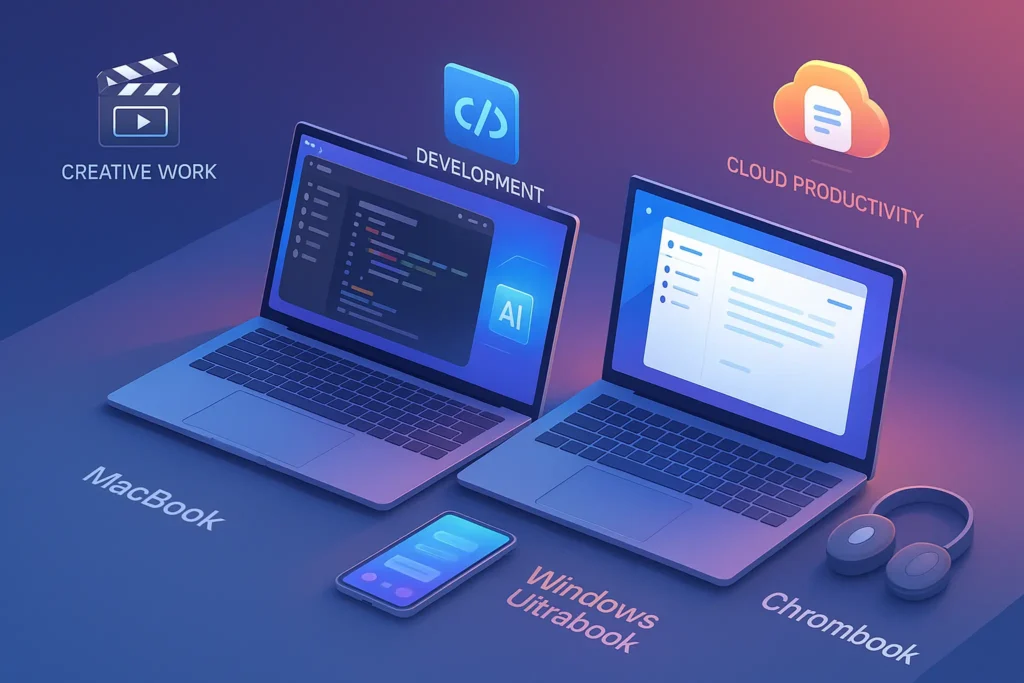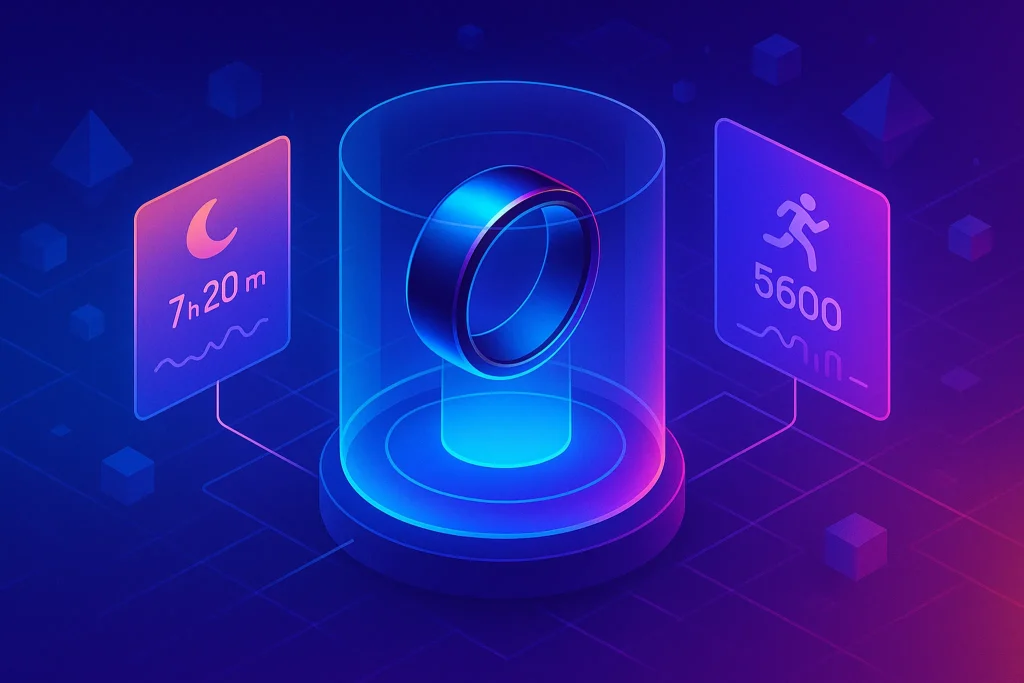-This post may contain affiliate links. If you click on one and make a purchase, I may earn a small commission at no extra cost to you.-
🔍 Introduction: Why the Wrong Laptop Can Cost You More Than Money
Buying the wrong laptop is more than just a financial mistake—it can derail your productivity, strain your daily routines, and even limit your potential. Imagine a designer stuck with laggy graphics, or a student frustrated by short battery life during long lectures.
With hundreds of models flooding the market, flashy specs and misleading marketing can make it hard to choose wisely. But here’s the truth: you don’t need the most expensive laptop—you need the right one for your use case.
In this guide, we’ll break down laptop categories and specs from a real-life perspective. Whether you’re a student, gamer, creator, or just need something reliable for everyday browsing, you’ll find exactly what fits your needs.
🎯 Define Your Use Case
Let’s start where most people should—but don’t: how are you going to use your laptop, really? Because specs only matter when tied to purpose. Here’s how to match real-life roles with real-life requirements.
👩🎓 Student
You need portability, decent battery, and web/app multitasking. Think 13–14″ ultrabook with 8–16 GB RAM and SSD. Example: Emily, a literature major, needed a device for online classes, note-taking, and research—she found a 14″ Intel i5 ultrabook perfect for dorm and desk use.
🕹️ Gamer
High refresh-rate display, dedicated GPU (RTX 40‑series or RX 7000), and good cooling. Core i7 + 16 GB RAM + SSD is sweet spot—not overkill like Core i9 that overheats and drains battery.
🎨 Freelancer / Designer
You’ll need color-accurate screen, GPU acceleration, and pen/touch support. A 2‑in‑1 or artist laptop with 16–32 GB RAM and RTX 4050 works great for Adobe CC workflows.
🧑💻 Day‑to‑Day User
Email, light editing, browsing—8 GB RAM and SSD is enough. Chromebooks or budget Intel/Pentium laptops shine here.
👨💻 Developer / Programmer
Fast CPU, 16 GB+ RAM, SSD, and if you compile often, even embedded GPU helps. Also consider ports—USB‑C and docking docking is key for multi-monitor setups.
⚙️ What Specs Actually Matter?
Let’s cut through the spec-sheet noise. The right laptop isn’t the one with the biggest numbers—it’s the one with the right balance for your use case. Here’s what really matters in 2025, and what doesn’t (unless you’re being upsold).
🔲 CPU (Processor)
-
Entry-Level (Everyday/Budget): Intel i3 / Ryzen 3
-
Mid-Range (Students, Devs, Light Creators): Intel i5 / Ryzen 5 (12th+ Gen)
-
High-End (Gamers, Creators, Power Users): Intel i7–i9 / Ryzen 7–9 / Apple M2–M3
✅ Real Example: A gamer doesn’t need a Core i9 unless they’re also editing 4K videos or streaming. An i5 with a good GPU performs just fine in 1080p gaming.
🧠 RAM (Memory)
-
8GB = Minimum for basic tasks
-
16GB = Sweet spot for most users in 2025
-
32GB+ = For pro-level multitasking, VMs, 3D rendering, etc.
📌 Nerd Tip: Always choose 16GB if you’re doing anything beyond browsing. Modern web apps eat RAM like candy.
💾 Storage: SSD vs HDD
-
SSD = Must-have. It drastically improves boot time, app launch, and overall snappiness.
-
256GB is the new minimum; 512GB recommended for media-heavy users.
-
External drives or cloud storage are cheap add-ons if internal space is tight.
🎮 GPU (Graphics)
-
Integrated (Intel Iris, Apple M3): Enough for light tasks, dev work, streaming
-
Dedicated (NVIDIA RTX / AMD Radeon): Required for gaming, 3D modeling, video editing
🎯 If you’re gaming-focused, don’t miss our Nvidia GeForce RTX 5090 Review—the beast of 2025.
🔋 Battery Life
-
Anything below 7 hours is tough for students or mobile workers
-
Aim for 10–14 hours in ultrabooks or MacBooks
-
Gaming laptops will always struggle here—plug-in is your best friend
🏋️♀️ Weight & Build
-
<3 lbs (1.3kg) = Ultra-portable
-
3–4 lbs = Most 14-15” laptops
-
>5 lbs = Desktop replacement, heavy gaming/workstations
Lightweight + solid build = less shoulder pain and fewer drops. Aluminum > plastic when possible.
Example: A gamer won’t gain FPS benefit from Core i9—it’s the GPU, not CPU, that drives your frame rate.
🎹 Keyboard Quality
If you type a lot, don’t compromise. A mushy, shallow keyboard will slow you down and cause fatigue.
Tip: ThinkPad keyboards and MacBook butterfly mechanisms are still top-tier.
🎥 Webcam & Mic
In a post-Zoom world, a good 1080p webcam with decent mics saves you from looking (and sounding) like a potato.
Tip: If you’re doing video calls or streaming, skip the 720p webcam trend.
🔌 Ports (Yes, They Still Matter)
One USB-C isn’t enough. Make sure your device has the ports you need: HDMI for presentations, SD for photography, USB-A for peripherals.
🔈 Speakers
Laptop speakers vary wildly. If you care about audio (meetings, music, editing), check reviews or go hands-on.
🎧 Fan Noise
Loud fans = annoying. Look for thermally optimized designs, especially if you’ll be in libraries or shared spaces.
📦 Laptop Categories Explained
Not all laptops are created equal. Here’s a quick breakdown of common types and what they’re really for:
-
Ultrabook: lightweight, long battery—great for travelers.
Best For: Students, professionals on the move
Traits: Thin, light, long battery life, premium build
Examples: MacBook Air, Dell XPS 13
-
2‑in‑1: tablet + laptop versatility for designers.
Best For: Artists, students, hybrid users
Traits: Touchscreen + stylus support, flexible hinge
Examples: HP Spectre x360, Surface Pro 9
-
Gaming Laptop: power-hungry, cooling-heavy—best for performance.
Best For: Gamers, creators, performance junkies
Traits: Dedicated GPU, powerful CPU, big fans
Examples: ASUS ROG Zephyrus, Lenovo Legion 5
-
Budget Laptop: cheap workhorses under $500 for everyday tasks.
Best For: Casual users, young students
Traits: Basic specs, good value, plastic build
Examples: Acer Aspire 5, Lenovo IdeaPad 3
-
Workstation: Xeon class, ECC RAM—CAD, video-editing pros.
Best For: Engineers, 3D artists, devs
Traits: Beefy specs, big screens, heavy duty
Examples: Dell Precision, MacBook Pro 16”, HP ZBook
🖥️ Mac vs. Windows vs. Chromebook
| Platform | Strengths | Ideal For |
|---|---|---|
| Mac | M-series efficiency, color accuracy, ecosystems | Design, Dev |
| Windows | Variety of builds, gaming, performance | Gamers, Custom setups |
| Chromebook | Budget-friendly, secure, browser-centric | Students, Light users |
Nerd Insight:
In our testing, the MacBook Air M2 gave unbeatable battery life for students and writers. But for gaming or heavy dev work, Windows wins for raw power and flexibility.
Compare Mac’s seamless DevKit vs Windows’ customizable gaming specs, or light and affordable Chromebooks for school environments and starting laptop buyers.
👨🎓 Student: Portability + Battery = Lifeline
You’re bouncing between classes, libraries, and cafés. You take notes, write papers, join Zoom calls, and occasionally stream Netflix. You care about battery life, low weight, and price.
Ideal Traits:
-
13–14” screen for balance of size and portability
-
Lightweight (under 3.5 lbs)
-
At least 8GB RAM, 256GB SSD
-
10+ hours battery life
-
Backlit keyboard for night study sessions
Example Use Case:
A college student who spends most of their day on campus needs a laptop that lasts all day on a single charge, boots up fast, and fits in a small backpack. Something like the Acer Swift 3 or Dell Inspiron 14 provides that blend of budget and reliability.
🎮 Gamer: Performance First, Looks Second
You want high frame rates, smooth performance, and thermal stability. RGB lighting is a plus, but what matters most is what’s under the hood.
Ideal Traits:
-
Dedicated GPU (at least RTX 3050 or higher)
-
16GB RAM minimum
-
144Hz+ refresh rate display
-
Good thermal system
-
Strong build to handle heavy use
Example Use Case:
A semi-pro gamer who plays Valorant and Elden Ring needs a machine that can handle modern AAA titles without lag. Something like the ASUS TUF F15 delivers 1080p gaming at 120fps without burning a hole in your wallet—or your lap.
💡 Nerd Tip: For those looking for full control, check out How to Build a Gaming PC from Scratch for desktop-level performance.
🎨 Freelancer / Designer: Display Accuracy + Multitasking
You spend hours in Figma, Photoshop, or Premiere. You want crisp visuals, color-accurate displays, and enough muscle for smooth editing.
Ideal Traits:
-
High-res screen (QHD or 4K) with 100% sRGB or DCI-P3
-
16GB+ RAM
-
SSD (512GB or more)
-
Powerful CPU (i7/AMD Ryzen 7)
-
Discrete GPU for rendering tasks
Example Use Case:
A freelance video editor working with 4K footage and motion graphics can’t afford lag during render. A machine like the MacBook Air M3 or Dell XPS 15 balances portability and power with stunning displays.
🧑💼 Everyday User: Reliable All-Rounder
Emails, browsing, YouTube, maybe some light photo edits. You want simplicity, durability, and a machine that “just works.”
Ideal Traits:
-
8GB RAM, SSD (256GB+)
-
Long battery life
-
14–15” Full HD screen
-
Solid keyboard & webcam
-
Price under $700
Example Use Case:
A work-from-home parent who uses the laptop for productivity apps and Netflix at night needs a dependable, fast-booting device. Laptops like the HP Pavilion 14 or Lenovo IdeaPad Flex 5 are perfect low-maintenance choices.
👨💻 Developer / Coder: RAM + Keyboard = Productivity Core
You spend your day between VS Code, terminal windows, and browser tabs. Multitasking, fast compile times, and typing comfort are your lifelines.
Ideal Traits:
-
16GB+ RAM
-
Fast CPU (i5 or i7, 12th/13th gen)
-
Comfortable keyboard
-
1080p+ screen
-
Linux compatibility (if needed)
Example Use Case:
A full-stack developer running Docker and local servers needs speed and RAM to avoid lag. A laptop like the Framework Laptop, ThinkPad X1 Carbon, or MacBook Pro M2 offers the reliability and speed devs demand.
🎁 Bonus: Underrated Laptop Features You Shouldn’t Ignore
When you’re shopping for laptops, it’s easy to obsess over CPU or RAM and completely overlook the features that actually impact your daily experience. Here are five underrated details that can make or break your satisfaction:
-
Keyboard Quality: Good key travel = pleasant typing and fewer errors.
-
Webcam/Mic: 720p is basic—look for 1080p & privacy shutter.
-
Ports: USB‑A + USB‑C + HDMI + microSD = flexibility.
-
Audio Quality: Speakers matter for Zoom & music.
-
Upgradability: User-replaceable RAM/SSD = future savings.
🚫 Common Mistakes to Avoid
-
Buying more power than needed: Don’t pay for an RTX 4080 if you’re just writing essays.
-
Ignoring keyboard and display quality: Specs don’t matter if your screen is dim or typing is a chore.
-
Going for HDD instead of SSD: It’s 2025. No excuse for slow spinning drives.
-
Not checking upgrade options: Some laptops solder RAM or storage. Know what you’re stuck with.
-
Falling for fake discounts: Always check multiple sources and reviews before buying that “deal.”
🧠 Nerd Verdict
Picking the right laptop isn’t about chasing specs—it’s about matching tools to tasks. After testing dozens across segments, our team found that the best laptops are those you forget you’re using—because they just work.
For students, ultrabooks like the Acer Swift 3 or MacBook Air M2 hit the sweet spot of price, portability, and battery. For gamers, the ASUS TUF series offers unbeatable value. And for creators, displays and GPU power should take priority.
🎯 Rule of thumb: Buy for the next 2 years, not just today.
❓ FAQ: Nerds Ask, We Answer
Q: Should I invest in the latest CPU for future-proofing?
A: Only if you’re doing CPU-heavy tasks (e.g. compiling, video editing). Otherwise, mid-tier is more practical and power-efficient.
Q: Is 8 GB RAM enough today?
A: For basic tasks yes, but 16 GB is safer for multitasking and long use.
Q: Mac ecosystem worth it?
A: Designers, video editors, and iOS devs get more mileage from macOS; budget Chrome/Windows machines serve general tasks well.
Q: Is 8GB RAM enough in 2025?
It’s the bare minimum. Go for 16GB if you’re doing more than light browsing and docs.
Q: Should I future-proof my laptop?
Yes—but don’t overkill. Prioritize what you’ll actually use (RAM, SSD, display) over hype features.
Q: Are Chromebooks worth it?
If you’re always online and mainly use Google apps—yes. For offline work or power use—skip.
Q: Can I upgrade later?
Check before you buy. Many ultrabooks have soldered RAM/SSD. Workstations and gaming laptops are more flexible.
💬 Would You Bite?
What’s your laptop type? Ultrabook minimalist or RGB-heavy gamer?
Drop a comment with your dream setup or tell us the worst laptop you ever owned—so others don’t repeat the same mistake!👇



